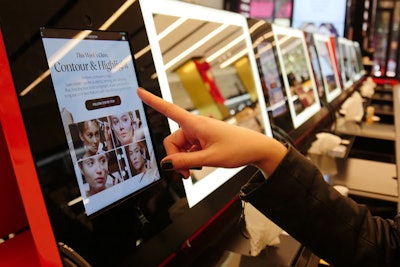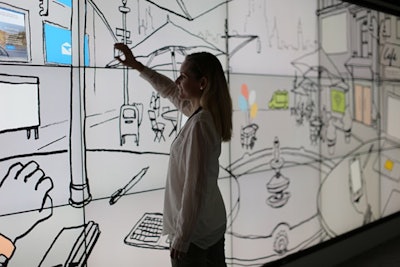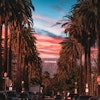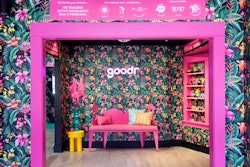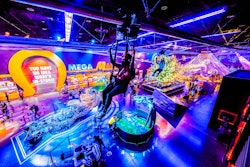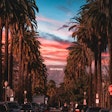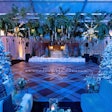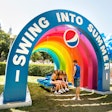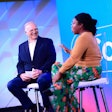At this year's C.E.S. in Las Vegas, Microsoft debuted its new Retail Experience Center (R.E.C.). The new immersive environment was designed to showcase the technology brand’s retail marketing solutions to its partners.
The space illustrated the company’s new vision for retail and took attendees’ through the nonlinear shopping journey of its consumers, highlighting the company’s philosophy of an “empowered buying” experience. "The customer is driving when, where, and how they will interact with the brand. At Microsoft, retail marketing is no longer just about how we merchandise or present products in a retail environment, but how we present products at all points of consumer interactions in a consistent way to make it simple and relevant for the customer," says Sean Ludick, general manager of worldwide retail channel marketing at Microsoft.
Microsoft isn’t the only company rejiggering its retail stores—both online and off. Many big-name brands and labels like Sephora and Rebecca Minkoff are testing out interactive and immersive experiences, hoping they’ll pay off in sales, positive word of mouth, and loyalty. Here are some new retail ideas and strategies that industry professionals can incorporate into their events and meetings:
Cater to millennials with play.
At the Sephora store on Powell Street in San Francisco, customers can now watch beauty tutorial videos via iPads and play with products at workshop stations. There, they can upload a selfie to their social media accounts as well as to the in-store display screen. The new interactive initiative is part of the brand’s “Teach, Inspire, Play” philosophy, which is “helping to take our stores to another level by offering creative spaces and community centers. We want to offer a fun, discovery-friendly, technology-enhanced environment that demystifies beauty and creates an encouraging place to explore,” explains Deborah Yeh, senior vice president of marketing and brand for Sephora.
Much like events that offer personalized, hands-on experiences, the beauty booths help keep distracted audiences engaged and entertained. “Consumers, especially younger millennials, expect and demand constant change, newness, and an environment that works for them and their needs,” says Yeh. The beauty stations are set to hit East Coast stores in the spring of 2016 with the opening of a Sephora location at the Prudential Center in Boston.
Grab attention with texts.
Last summer, Nordstrom launched TextStyle, a messaging service that allows its customers to contact, as well as buy directly from, sales associates or personal stylists via text conversation. Aimed at customers who prefer to text, such as millennials who grew up with messaging, TextStyle offers quick responses as opposed to traditional customer service forms. MailChimp’s Gather tool offers a similar SMS system for event planners, allowing them to communicate and update guests during events with must-read notifications.
Rethink old methods.
Designer Rebecca Minkoff is set to debut a new model for her fashion shows during New York Fashion Week: The Shows in February. Instead of showing the Fall 2016 collection, the brand will present an in-season show with products that are currently available or will be available in the next 30 to 60 days. “Our goal has always been to look and see where there are inefficiencies within the existing fashion supply chain and see if we can create solutions within those that can create either a closer relationship with the customer [or] a closer relationship with our retailers, and spot those things and look to disrupt them,” Minkoff says. “We want this model to be what Fashion Week should become. This should be the new model for the industry.”
The immediacy of social media, while hugely beneficial, has proven to be a double-edged sword and prompted the need for a new strategy. “We have found that the significance of fashion shows that present collections four to six months before they land in stores have allowed consumers to become bored with the styles that they’ve seen on celebrities and social media and they don’t necessarily want to buy them when they finally become available to them months later,” says the designer. “We really wanted to engage with our customer and think about what the ideal new model [could] be in terms of Fashion Week that takes into account retail partners, one’s own stores, social media platforms, and consumers.”
Break down barriers with tech.
In October 2015, Tommy Hilfiger offered shoppers front-row seats—via Samsung Gear VR headsets—to the brand’s Park Avenue Armory show, which originally took place in February in New York. The virtual reality experience also provided an exclusive backstage sneak peek. Customers could then immediately shop the collection in stores. Minkoff also commissioned a virtual reality recording of her Fall 2015 show, making it available to consumers via a customized version of a Google Cardboard headset. With the release of the Oculus Rift headset in the first quarter of this year, virtual reality will become more accessible, allowing events to potentially be more inclusive.
Use data to foster community.
In November, Amazon opened its first brick-and-mortar store in Seattle—with the help of its customers. Thanks to algorithms, pre-order data, and user reviews, the online retailer is able to stock its shelves based on shoppers’ needs and wants. Most of the books in the store feature a display card with a rating and a user-submitted review. And while using attendee feedback to tailor events isn’t a new concept, planners can help bring together like-minded attendees (in the vein on Amazon.com’s “customers who bought this item” feature) by utilizing crowdshaping data even more.
